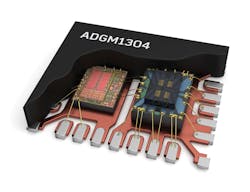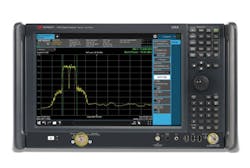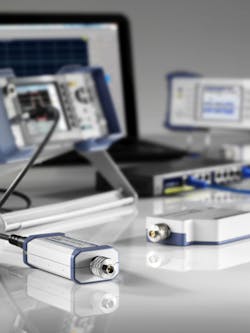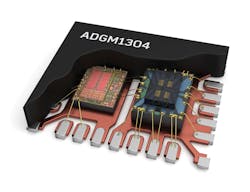Instrument and chip vendors boost high-frequency test
The closing quarter of 2016 saw a variety of RF/microwave technology innovations. The European Microwave Week (EuMW), held Oct. 4-6 in London, was the focus for much of the news, with Keysight Technologies debuting a new signal analyzer, National Instruments highlighting an advanced driver assistance system (ADAS) test solution, and Rohde & Schwarz demonstrating radar, satellite, semiconductor, and automotive test systems. Wolfspeed, in conjunction with NI, delivered a presentation on high-power MMIC design and introduced GaN HEMT devices. In addition, electronica 2016, held Nov. 8-10 in Munich, offered an opportunity for vendors to highlight RF/microwave innovations. Analog Devices, for example, chose the event to introduce RF MEMS switches that open up opportunities for new architectures in instrument and ATE designs.
Keysight Technologies announced at EuMW what it calls an industry-leading breakthrough in spectrum and signal analysis at millimeter-wave (mmWave) frequencies—the Keysight N9041B UXA X-Series signal analyzer (Figure 1), which the company previewed just before our December special report on communications test went to print.1
Courtesy of Keysight Technologies
Mario Narduzzi, director, Communications Solutions Group Marketing, said in a phone interview before EuMW that the Keysight N9041B UXA X-Series signal analyzer is the first to provide frequency coverage to 110 GHz with a maximum analysis bandwidth of up to 5 GHz with an external oscilloscope. Key target areas include mmWave 5G and automotive radar.
Narduzzi provided some background on the push for mmWave. “In the wireless arena,” he said, “we have massive growth in data demand—fixed, nomadic, mobile. mmWave will play an important role in addressing this need.” He also cited the huge growth in the number of connected devices with the coming of the IoT, with an explosion in the diversity of wireless applications including gesture control and augmented reality.
With respect to radar, he said, “As we know, radar is not new technology, having been widely deployed in aerospace and defense. Applying radar to the automotive industry is, however, relatively new and driven by automotive safety imperatives.” Challenges, he said, include resolving targets in dense urban environments and ensuring minimum interference between different systems on cars operating in close proximity. In addition, as sensors proliferate (for functions including adaptive cruise control, blind-spot monitoring, lane-change assist, and advanced emergency braking), they must be increasingly more compact.
Consequently, he said, designers of mmWave systems for 5G and automotive applications must deal with small dimensions and complex test setups, make ultrawideband mmWave I/Q measurements, and contend with small signal strength—because of the spreading of power over wide bandwidths and the inherent lossy nature of high-frequency signals.
“We recognize that these measurements aren’t easy,” he said, but the N9041B UXA can provide an assist. “The complexity typically dealt with by designers, who have to deal with complicated downconvertors or an external mixer often with images, has been solved,” he said. “You now can see the whole picture and focus on solving your design challenges rather than measurement complexity.”
The N9041B UXA employs advanced front-end indium-phosphide circuitry that achieves low loss and efficient mixing, providing a displayed average noise level as low as -150 dBm/Hz when characterizing wideband modulated mmWave signals.
Radar test
Rohde & Schwarz addressed a variety of applications areas at EuMW. The company said its portfolio for radar test applications covers requirements both at the component and the system levels. For characterizing active modules such as transmit/receive modules, Rohde & Schwarz offers a test solution consisting of its R&S ZVA network analyzer, which operates to 67 GHz, and the R&S ZVAX TRM extension unit. The latter provides signal conditioning for demanding measurements on active components. The R&S FSWP phase noise analyzer and VCO tester offers high sensitivity and measurement speed for phase-noise tests on pulsed sources.
For developers and manufacturers of radar systems, Rohde & Schwarz features a solution for radar echo simulation based on the R&S SMW200A vector signal generator. This solution can simulate moving objects, Doppler frequencies, and radar cross sections, enabling users to significantly reduce the need for expensive and cumbersome field tests.
Courtesy of Rohde & Schwarz
The company also highlighted satellite test solutions. For users in the satellite communications sector, Rohde & Schwarz offers its new R&S NRP(N) generation of power sensors (Figure 2), which are suited to power measurements on directional and satellite radio components. Each sensor combines USB and LAN interfaces, enabling them to bridge large distances between the DUT and the user.
The company also offers a satellite link test solution based on the R&S SLG satellite load generator. The R&S SLG can generate up to 32 transponder signals or a single 500-MHz bandwidth signal, enabling the efficient testing of components, satellite systems, and receivers as well as the simulation of live video and data links in real time.
Rohde & Schwarz also addressed semiconductor test, highlighting the company’s partnership with MPI for high-quality on-wafer test. MPI makes probe stations such as the TS150-THZ, which addresses the challenging test requirements of multiple emerging markets and applications, such as automotive radar, noninvasive imaging, defense, security and surveillance, short-range radar, and 5G communications. At EuMW, Rohde & Schwarz cited the probe stations’ mechanical stability and prober handling features, which complement the R&S ZVA high-end network analyzer and enable highly reproducible results.
Automotive applications
Finally, Rohde & Schwarz highlighted automotive applications, elaborating on input it provided for a recent EE special report on the topic.2 For automotive radar testing, the R&S FSW85 signal and spectrum analyzer evaluates FMCW chirp signals with up to a 2-GHz bandwidth and covers the 24-GHz and 79-GHz frequency bands allocated to automotive radars without any additional external frequency converters. In addition, the R&S TS7124 shielded PXIe test box and the R&S NRP8S power sensor support production tests on automotive radar sensors.
National Instruments, too, addressed automotive applications at EuMW. The company demonstrated a new ADAS test solution designed for short- and long-range radar and based on NI’s mmWave front-end technology and the recently released PXIe-5840 second-generation vector signal transceiver (VST).
The ADAS test solution combines NI’s second-generation PXIe-5840 VST with banded, frequency-specific upconverters and downconverters designed to test the 76- to 81-GHz radar band with 1 GHz of real-time bandwidth. The system can function as an mmWave vector signal generator and vector signal analyzer because of this design. Engineers can program the VST’s FPGA with LabVIEW to use the ADAS test solution for radar target emulation, a technique in which test equipment emulates the radar cross section, range, radial velocity, and angle of arrival of a particular object. This is essential for testing a radar system’s software and hardware.
“NI’s new ADAS test solution offers a unique approach to radar characterization and testing with its scalable capability to conduct both traceable PXIe measurements and system simulation,” said Stefano Concezzi, vice president of the global automotive initiative at NI, in a press release. “With regulatory requirements still evolving, the flexibility of this solution allows engineers to quickly adapt their test systems to address the challenges of new radar scenarios.”
“Radar is the key technology of the future, and the importance of radar-system reliability requires advanced approaches to testing,” added Niels Koch, radar component owner at Audi. “With the PXIe VST, the combination of wide bandwidth and low-latency software allowed us to discover an automotive radar sensor like never before—even allowing us to identify critical bugs in our radar module that we could not detect before.”
And in related EuMW news from chipmakers, Wolfspeed delivered a presentation titled “Streamlined MMIC Design for High Power, High Frequency Applications” at the PXIe and Microwave Power Amplifier Forum sponsored by NI. Wolfspeed also officially released two new products. First was the 900-W CGHV14800 GaN HEMT for L-Band radar applications, which the company called the highest power 50-V GaN HEMT demonstrated to date. Second was the CGHV59070 GaN HEMT for C-Band radar systems, which is suitable as a driver for what the company calls the highest power C-Band radar device on the market, Wolfspeed’s 350-W CGHV59350 GaN HEMT for 5.2- to 5.9-GHz operation. Both systems were demonstrated earlier this year at the International Microwave Symposium.3
RF MEMS switches
Courtesy of Analog Devices
As this article went to print, electronica 2016 was underway in Munich. Analog Devices took advantage of the event to introduce the ADGM1304 SP4T 0-Hz (DC) to 14-GHz switch (Figure 3), which has applicability in network and spectrum analyzers as well as oscilloscopes and AWGs.
In a phone interview the week before electronica, Ray Goggin, product line manager for switches, multiplexers, and voltage references, said the new MEMS switches represent the latest initiative in ADI’s MEMS technology extending back to 1991, when the company introduced its first accelerometer for airbag deployment using ADI’s proprietary iMEMS process. To date, he said, the company has shipped more than 1 billion inertial sensors for automotive, industrial, and consumer applications. The MEMS switches, he added, represent a new category for the company.
Each of the new switches, he said, comes in a 5-mm x 4-mm x 0.95-mm QFN package. Features include a five-contact gold-beam electrostatically actuated cantilever switch design with metal-hardened contacts. The switch is copackaged with a high-voltage, low-power drive IC.
The switch offers an on resistance of less than 2 Ω and off leakage current of 0.5 nA. Total harmonic distortion (THD+N) is -110 dBc. Goggin said that for future implementations these specs can be improved through beam and substrate optimization. Third-order intermodulation intercept is 69 dBm over the full frequency range of operation—this performance can potentially be increased beyond 75 dBm. RF power handling is 40 dBm over the full frequency range, with 200 mA of DC current handling per switch. The switches are guaranteed for 1 billion actuation cycles; Goggin said the company has demonstrated levels beyond the 1 billion number.
Goggin cited a critical figure of merit for switch technology: on resistance multiplied by off capacitance, or RonCoff. “As RonCoff reduces, the insertion loss of the switch also reduces, and the off isolation improves,” he said. “The ADI MEMS switch-technology RonCoff product for a single switch unit is <8, guaranteeing its position as the technology of choice to enable world-class switch performance.”
Goggin cited several test-and-measurement instrumentation applications for the MEMS switches, including the filter-bank switching needed for wideband instruments where different frequency bands are implemented using different RF architectures. They also can be used for attenuator switching to improve dynamic range or for channel multiplexing.
The MEMS switches, he said, offer the opportunity to consider new instrument architectures—involving, for example, a low-loss multi-throw front end or zero IF architecture with mixing stages removed. He also cited ATE applications, including general digital and RF signal routing on load boards. A key benefit, he said, includes a 90% area savings compared with a DPDT electromechanical relay.
In addition to test and measurement, Goggin said, the MEMS switches can serve in aerospace/defense, healthcare, and consumer and communications applications spanning 5G, IoT, and WiGig (802.11ad). In conclusion, he said, the new MEMS switch line complements the company’s analog, SOI, and GaAs switch offerings.
References
- Nelson, R., “Tackling challenges in the time and frequency domains,” EE-Evaluation Engineering, December 2016.
- Nelson, R., “Vehicle communications drive test challenges,” EE-Evaluation Engineering, October 2016, p. 8.
- Nelson, R., “Wolfspeed demonstrates GaN HEMT devices at IMS,” EE-Evaluation Engineering Online, May 26, 2016.
For more information
About the Author

Rick Nelson
Contributing Editor
Rick is currently Contributing Technical Editor. He was Executive Editor for EE in 2011-2018. Previously he served on several publications, including EDN and Vision Systems Design, and has received awards for signed editorials from the American Society of Business Publication Editors. He began as a design engineer at General Electric and Litton Industries and earned a BSEE degree from Penn State.



